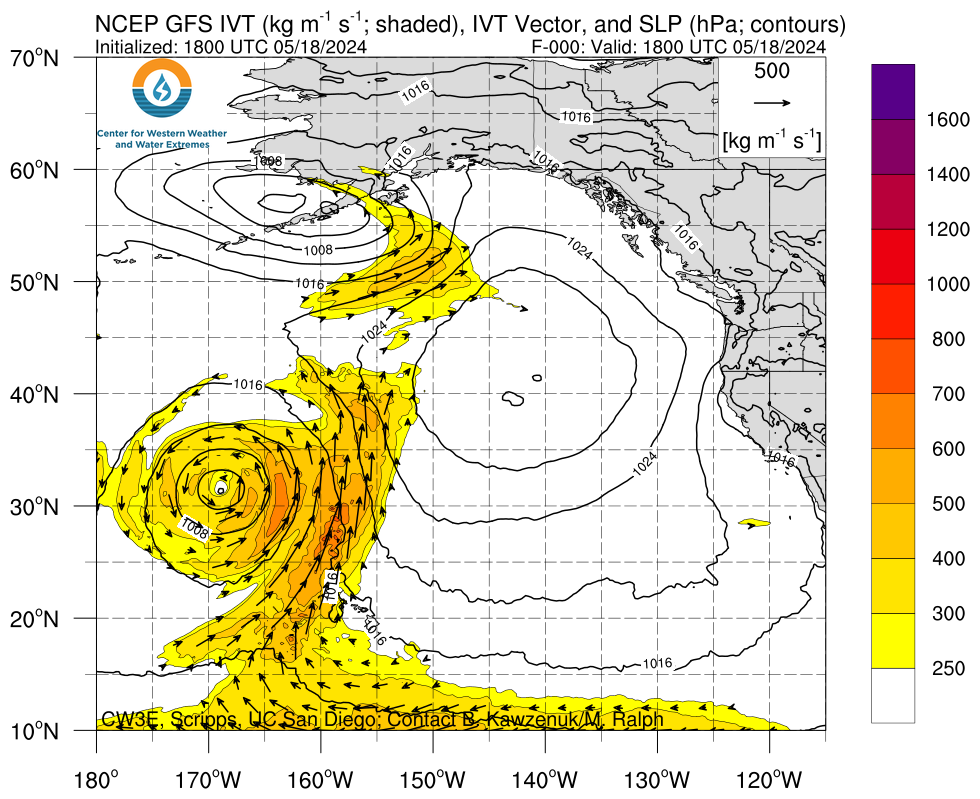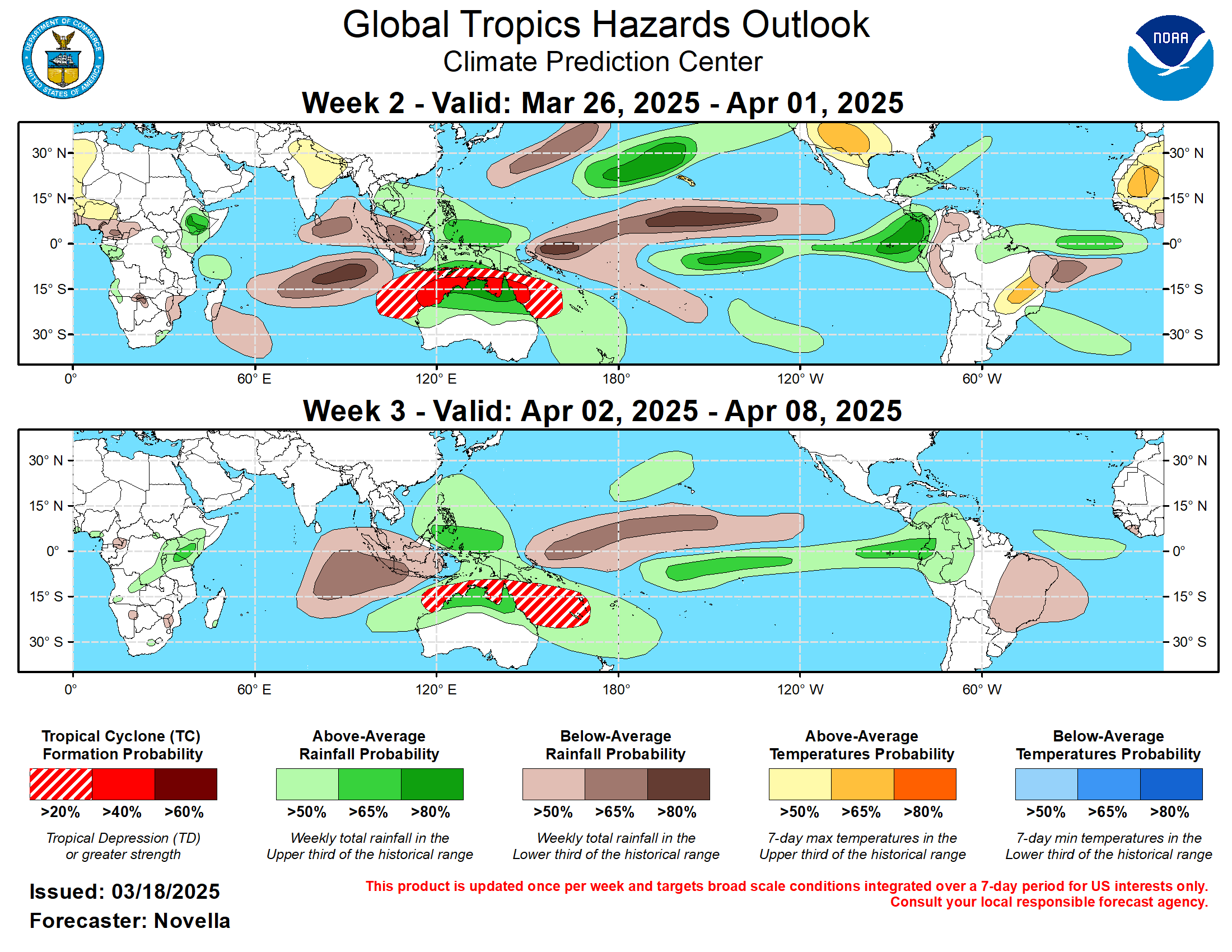This article focuses on what we are paying attention to in the next 48 to 72 hours. The article also includes weather maps for longer-term U.S. outlooks and a six-day World weather outlook which can be very useful for travelers.
First the NWS Short Range Forecast. The afternoon NWS text update can be found here after about 4 p.m. New York time but it is unlikely to have changed very much from the morning update. The images in this article automatically update.
Short Range Forecast Discussion
NWS Weather Prediction Center College Park MD
Tue Aug 27 2024
Valid 12Z Tue Aug 27 2024 – 12Z Thu Aug 29 2024…A brief spell of record heat expected to spread from the Midwest to the
East Coast……Active showers and severe thunderstorms this morning across the
northern Plains and upper Midwest/Great Lakes will shift eastward into the
northern Mid-Atlantic/southern New England by late Wednesday into early
Thursday……First snowflakes of the season could reach the higher elevations of
northwestern Montana on Wednesday followed by a chance of severe
thunderstorms across North Dakota Wednesday night/early Thursday…The closed upper high currently centered over the mid-Mississippi Valley
will be expanding eastward over the next two days, spreading into large
portions of the East Coast from the Mid-Atlantic southward. This will
send a quick spell of potentially record high temperatures from the
Midwest into the Ohio Valley, Tennessee Valley, southern to central
Appalachians and into the Mid-Atlantic. The combination of hot
temperatures in the mid to upper 90s to near 100 degrees together with
high humidity levels will produce maximum daily heat indices of between
105 and 115 degrees across these regions, with heat risks reaching major
to extreme levels today across the Midwest into lower Great Lakes.
Excessive Heat Warnings and Heat advisories are currently in effect across
the mid to upper Mississippi Valley, the Midwest and southern New England,
affecting nearly 61 million people, with further expansion of these
warnings and advisories possible into portions of the Mid-Atlantic for
Wednesday. This spell of record heat will be relatively short-lived as a
cool high pressure system settling into southern Canada is forecast to
send a cool and damp air mass into the Great Lakes on Wednesday and will
quickly overspread New England Wednesday night, reaching into the
Mid-Atlantic by Thursday morning behind a sharp cold front.Around the peripheries of the above mentioned upper high, precipitation is
likely to be active along the Gulf Coast and from portions of the
Southwest, northeastward into the Central Plains, upper Mississippi
Valley, upper Great Lakes into northern New England in this “ring of
fire”. In these regions, moisture values are forecast to remain above
average, supporting the potential for areas of active thunderstorms, heavy
rains and flash flooding. Active showers and severe thunderstorms this
morning across the northern Plains and upper Midwest/Great Lakes could
result in areas of heavy rains and flash flooding. Some of these
thunderstorms are expected to shift eastward into the northern New England
by early Wednesday, before some additional strong to severe thunderstorms
and heavy rain possible across portions of the upper Ohio Valley, central
Appalachians and into the Mid-Atlantic later on Wednesday into early
Thursday ahead of the sharp cold front.While much above to record high temperatures dominate portions of the
central to eastern U.S. into mid week, another strong front will be
pushing inland into the Pacific Northwest followed by the northern Rockies
and into the northern High Plains by this evening. Much below average
temperatures in the wake of this front will likely spread across the
Pacific Northwest for today and into the northern Rockies/northern High
Plains on Wednesday with high temperatures 10 to 20 degrees below average.
There is not expected to be a lot of precipitation with this front over
the Northwest, but the falling temperatures could bring the first
snowflakes of the season for the higher elevations of northwestern Montana
on Wednesday. By Wednesday night into early Thursday, a chance of severe
thunderstorms will be moving eastward across North Dakota ahead of the
strong cold front.
To get your local forecast plus active alerts and warnings click HERE and enter your city, state or zip code.
Learn about wave patterns HERE.
Then, looking at the world and of course, the U.S. shows here also. Today we are looking at precipitation.
Please click on “Read More” below to access the full Daily Report issued today.
| Notices: What would you like to learn about? Please provide that to me via the comment section at the end of the article. |
Now more detail on the 48-Hour Forecast (It is a 48 to 72 Hour Forecast actually)
Daily weather maps. The Day 1 map updates twice a day and the Day 2 and 3 maps update only once a day. These maps update automatically. But if that does not happen, you can get updates by clicking HERE
TODAY (or late in the day the evening/overnight map will appear) (Key to surface fronts shown on maps and you will then also be able to insert a city name or zip code and get a local NWS forecast).
TOMORROW
NEXT DAY
We have a new animation of the forecast which shows how things may play out over the next 60 hours. To update click ANIMATION. Doing so will get you to the dashboard. You can then step through the animation or hit LOOP on the upper right of the display. You will have to hit the back arrow ← at the top left on your computer to get back into this article. It is a little more trouble than before but I think NOAA scrapped the animation routine I was using so we have to keep up with “progress”.
The NWS Climate Prediction Center’s: Watches, Warnings, and Advisories plus other information can be found HERE. That takes you to the NWC Severe Weather Site. From there you can select among many categories of information. Remember to hit the back arrow ← at the top left of your screen to return to this article.
ATMOSPHERIC RIVERS
This tells us what is approaching the West Coast. Click HERE to update If I have not gotten around to doing the update. Here is some useful information about Atmospheric Rivers.
Below is the current five-day cumulative forecast of precipitation (Updates can be found HERE)
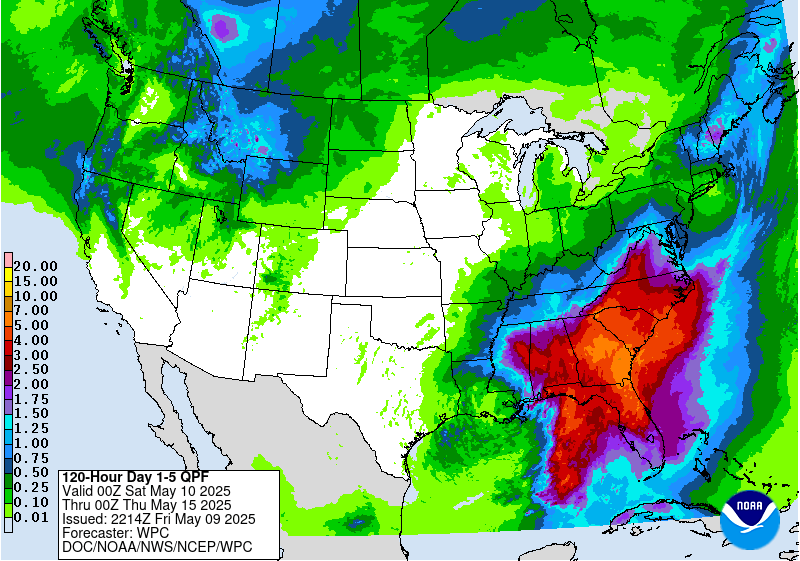
Ski SnowReports will Resume in the Fall.
Now we look at Intermediate-Term “Outlook” maps for three time periods. Days 6 – 10, Days 8 – 14, and Weeks 3 and 4. An outlook differs from a forecast based on how NOAA uses these terms in that an “outlook” presents information as deviation from normal and the likelihood of these deviations.
Below are the links to obtain updates and additional information. They are particularly useful if you happen to be reading this article significantly later than when it was published. I always try to provide readers with the source of the information in my articles. These links may also be useful for those viewing this article on a cell phone or other small screen.
| Days 6 – 10 (shown in Row 1) | Days 8 – 14 (Shown in Row 2) | Weeks 3 and 4 (Shown in Row 3 but updates only on Fridays) |
| https://www.cpc.ncep.noaa. gov/products/predictions/610day/ | https://www.cpc.ncep .noaa.gov/products/predictions/814day/ | https://www.cpc.ncep.noaa.gov/products/predictions/WK34/ |
Showing the actual maps. They should now update automatically. The Week 3 – 4 Outlook only updates on Fridays. So below is what I call the Intermediate-term outlook. On Fridays, it extends out 28 Days. That declines day by day so on Thursday it only looks out 22 days until the next day when the Week 3 – 4 Outlook is updated and this extends the outlook by one additional week.
| 6–
10
|
|
|
| 8–
14 |
|
|
| 3–
4 |
|
|
HAZARDS OUTLOOKS
Click here for the latest complete Day 3 -7 Hazards forecast which updates only on weekdays. Once a week probably Monday or Tuesday I will update the images. I provided the link for readers to get daily updates on weekdays. Use your own judgment to decide if you need to update these images. I update almost all the images Friday Night for the weekend edition of this Weather Report. So normally readers do not need to update these images but if the weather is changing quickly you may want to.
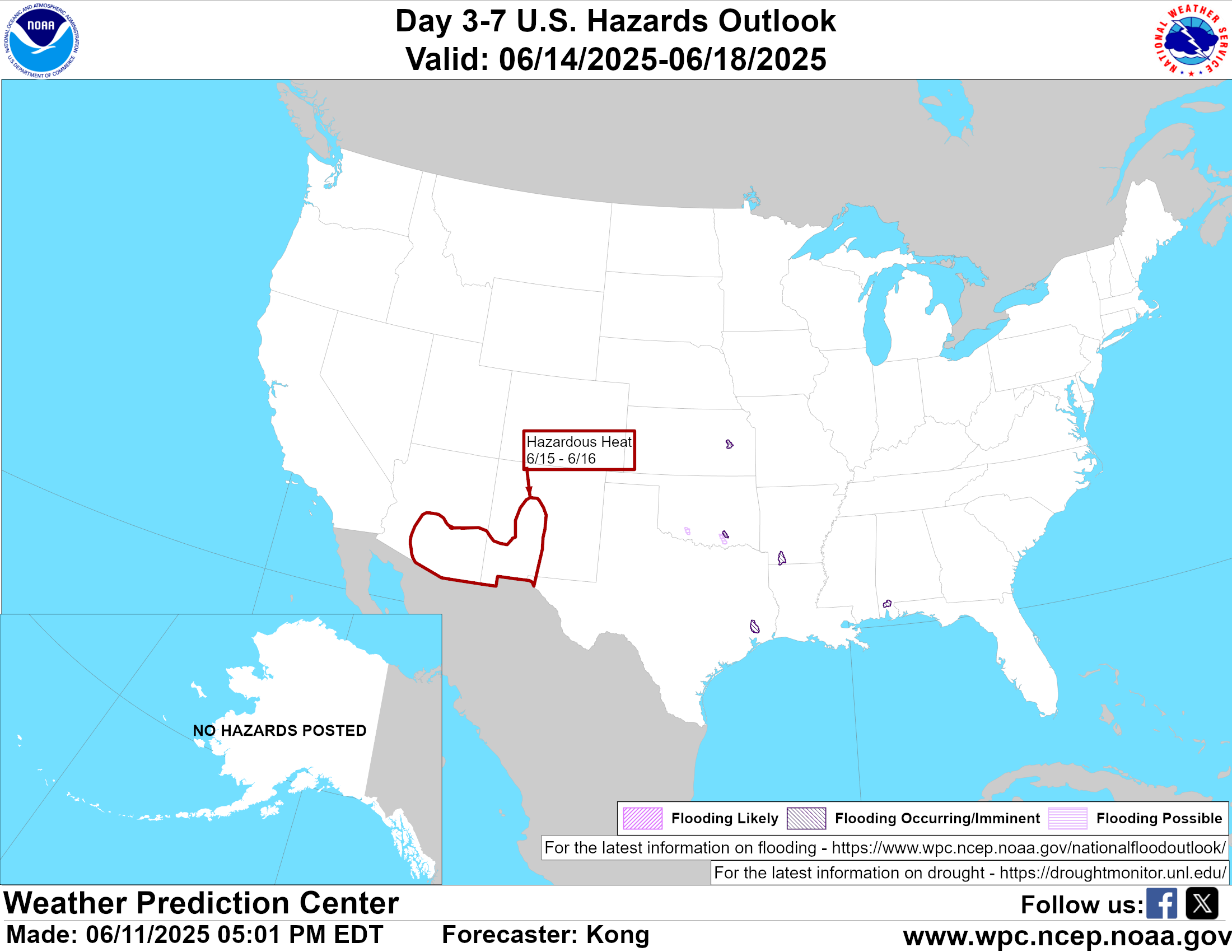
Temperature month to date can be found at https://hprcc.unl.edu/products/maps/acis/MonthTDeptUS.png
Precipitation month to date can be found at https://hprcc.unl.edu/products/maps/acis /MonthPNormUS.png
World Forecast [that website is has been intermittent so be patient]
Below are the Day 1 -3 and 4-6 forecasts for temperature and precipitation. Updates and much additional information can be obtained HERE
World Temperature Anomalies

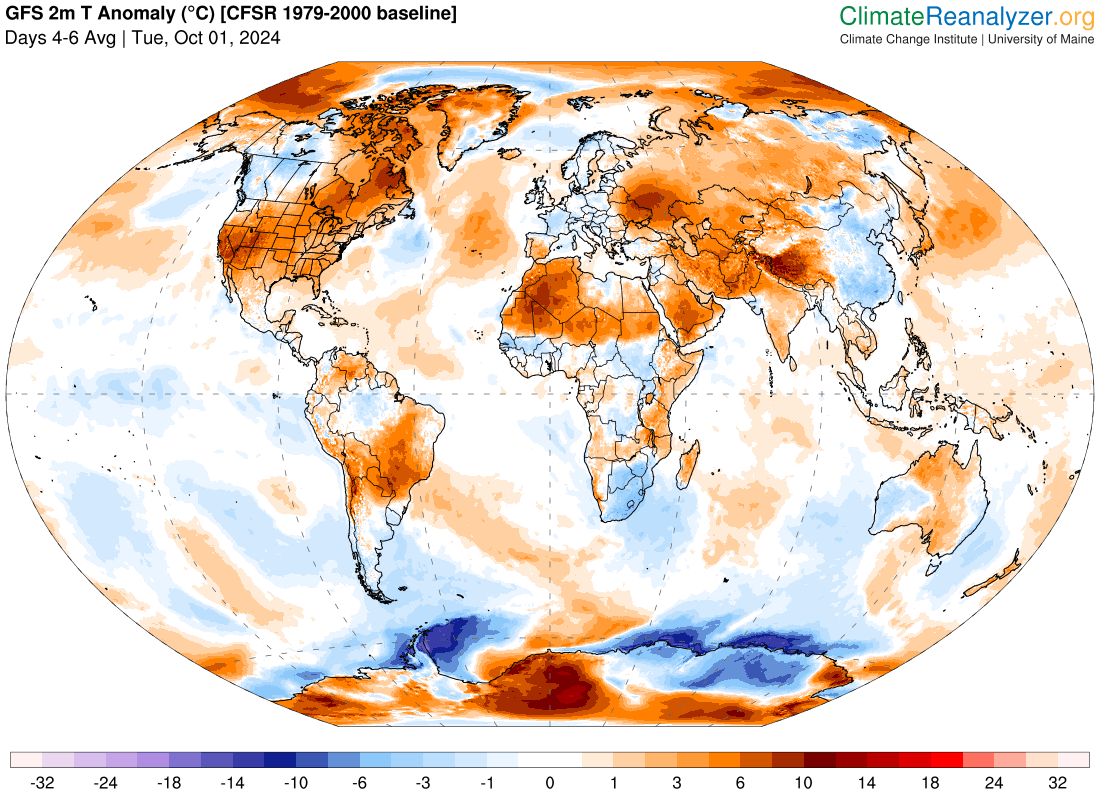
World Accumulated Precipitation
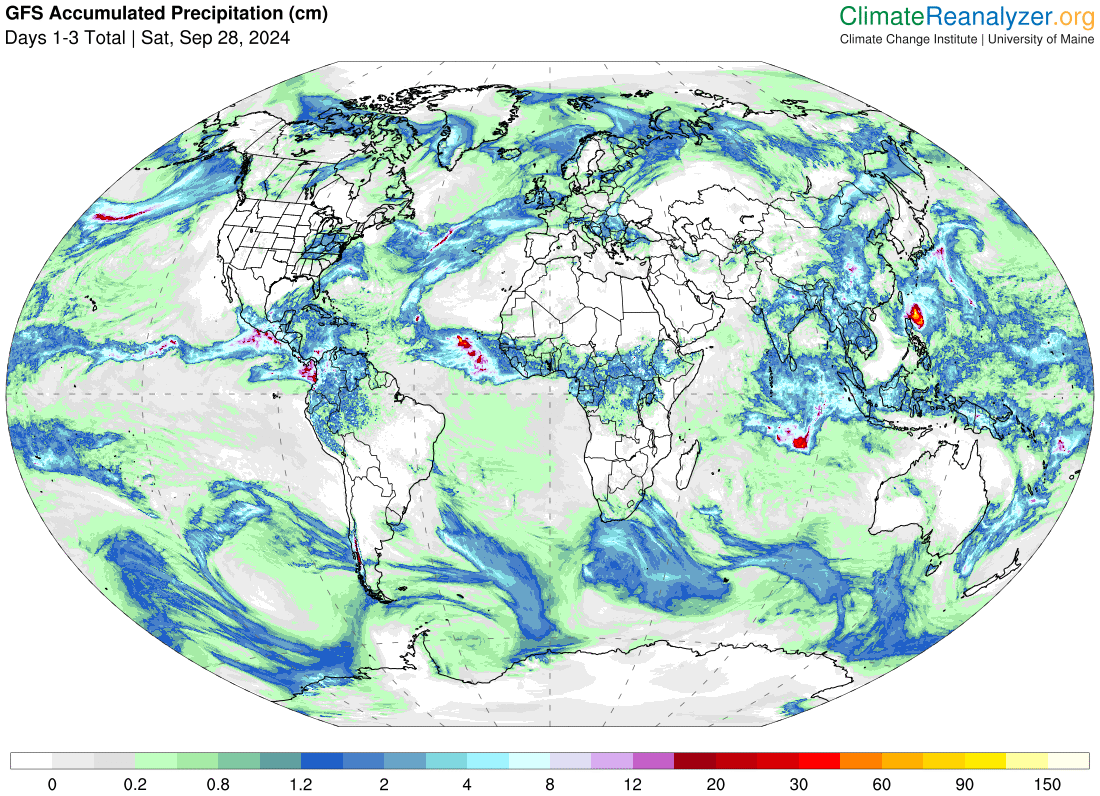

This information is provided by the University of Maine. They draw upon many different sources. There is a lot of information available at the link provided. I have just provided two useful forecasts. There are probably over a hundred different forecasts available from this source.
Worldwide Tropical Forecast (This is a NOAA Product)
This graphic updates on Tuesdays) If it has not been updated, you can get the update by clicking here Readers will only have to do that if they are reading this article much later than the date of it being published.
Information on Tropical Storms can be found HERE. Western Pacific information can be found HERE. Note that unless there is an out-of-season storm the below images will not update until the National Hurricane Center starts their seasonal update of these maps on June 1. I include them simply because there can be an out-of-season event in which case it should show up in these maps.

–
I hope you found this article interesting and useful. –

